
Chickweed is a favorite wild edible but only shows up in our wintertime.
My first chickweed of the season was spotted during our foraging class last Saturday in Orlando at Blanchard Park. As few sprigs were found elsewhere in the park its been growing this past month. Among the wild edibles it is fairly easy to identify with several distinct characteristics. Chickweed has a line of hair on the stem that switches sides at every node (where there are two leaves.) It also has a stretchy inner core and tastes like raw corn. Add the time of year here — our winter — and it’s an easy-to-identify foragable. To read more about chickweed go here.

Goosegrass was used to separate the curds from the whey. Photo by Green Deane
Chickweed was not the only first sighting of the season. Along the Seminole Wekiva Trail this past Sunday I also spied Goosegrass, Galium aparine. It’s another of our fleeting winter edibles that’s around for a couple of months then gone. Young leaves and shoots are edible raw, as they toughen they should be cooked. At some point Goosegrass becomes too tough to eat. Reportedly the species is good for the lymph system. One odd thing is that Goosegrass is in the coffee family. The seeds, small as they are, can be roasted and do have a coffee flavor. Add a few Yaupon leaves and you have a wild coffee with caffeine. The easiest way to know you have the right Goosegrass is 1) it has whorls of six, seven, and eight leaves and it sticks to you like velcro. To learn more about Goosegrass go here. Also check out the foraging classes below for different locations over the next two weeks which include the Seminole Wekiva Trail.
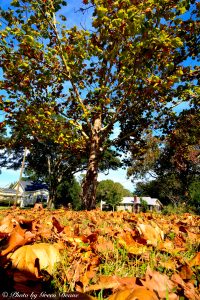
Sycamores drop a lot of leaves.
If Longfellow had lived elsewhere — say Europe — he might have penned in his famous poem: “Under the shedding Sycamore tree the village smithy stands.” As it was Longfellow wrote about the mighty American chestnut which sadly because of a blight is nearly no more. And while mentioning Longfellow take a look at his picture below left. Most of the photos of him show an old bearded man. This was taken when he was much younger, in 1855, when photography was young, too. And unlike other pictures from the time it’s not staged or posed. It’s more natural and gives us a glimpse of the man and personality. There’s a bit of destiny in Longfellow’s eyes. And what did he do right after the photo was taken? Go out to dinner because he was already dressed up? Or tell the photographer he’d pay him for the (then) expensive photo next week when one of his new poems sold? When I see old photos like this I wonder what the next moment was like, when they broke pose and went on with living. Photographs are frozen slivers of time.
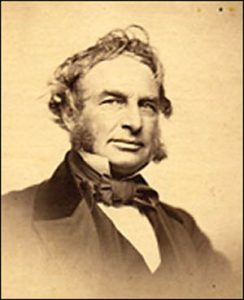
Henry Wadsworth Longfellow, age 48
Unlike Longfellow’s chestnut tree the Sycamore gets a bad rap because of what you see in the picture above, leaves…. lots of large leaves in the yard. To me it’s attractive fall colors and in time more stuff for the compost pile. But, Sycamore Leaves are the bane of many homeowners who want carefree landscaping. But Sycamores are forager friendly. The sap is drinkable and one could make a syrup out of it if one wanted to spend the time and energy. The sap tastes like slightly sweet water and it is already filtered by the tree so also quite safe to drink. The wood is inert so it can be used in a variety of ways with food or cooking, from skewers over the campfire to primitive forks et cetera. To read more about the maligned Sycamore go here.
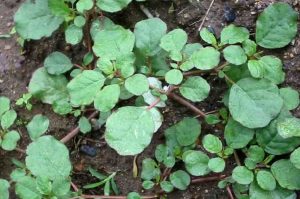
Trianthema portulacastrum, Desert Horse Purslane, a potential edible that on a glance can resembles purslane or the Tar Vine.
I’ve also noticed a plant locally that looks like Tar Vine. I have foraged Tar vine and this plant is similar but it is not quite. It is very tempting to make it fit the Tar Vine description, particularly when the plant hasn’t blossomed. You must avoid that. Waiting for the blossom is always good form. None of us are so hungry we must eat a new wild plant NOW! Take your time. The look of Tar Vine that I have in my head lets me see similar pattens in this new plant but also tells me it is not the Tar Vine. I think it might be Trianthema portulacastrum, a possible edible. My problem plant can also resemble purslane at times. You can read more about the “Desert Horse Purslane” with this study.

Classes are held rain or shine, hot or cold. This Dwarf Plantain was seen on our Saturday foraging class.
Foraging Classes: The holiday season brings a few changed to the foraging classes. Saturday’s class is in Cassadaga near Deland. It’s a nice location that usually draws a small class so there’s a lot of individual attention. Sunday’s ‘s foraging class is a new location, Sanlando Park in Seminole County near Altamonte Springs. Sanlando Park is a popular tennis site but it is also next to the Seminole Wekiva Trail and some good acerage of woods and fields. We meet 9 a.m. at the first parking lot on your right after the entrance on Laura Avenue (yes, they are open 8 to 5 the day before Christmas.)
This past week Blanchard Park was where the class met and wandered. It gave us an opportunity to view not only seasonal impact but how water flow can affect where plants choose to grow. There were long strips of seasonal edibles such as Dwarf Plantains, Cucumber Weed, West Indian Chickweed, small mustards, and Stinging Nettles. We also managed to find a Sugarberry Tree still clinging to some fruit.
Saturday, December 23, Colby-Alderman Park: 1099 Massachusetts Street, Cassadaga. Fla. 32706. 9 a.m.
Sunday, December 24th, Sanlando Park, 401 West Highland St.
Altamonte Springs, Florida 32714 (at the intersection with Laura Avenue.) 9 a.m. We meet in the first parking lot on your right immediately after the entrance. This class involves about three miles of walking over several hours.
Saturday, December 30th, Eagle Park Lake, 1800 Keene Road, Largo, FL 33771. 9 a.m. This is close to Clearwater Fl. Meet near the bathrooms near the dog park. This class is a request for me to hold a foraging class in a place I’ve never visited. So when I say meet near the bathrooms near the dog park I will be looking for them as well. I don’t know how far we will walk nor what parts of the park we will visit. The point is to hold a foraging class site unseen. So if you want to see how I find edibles it’s a class to attend. It’s going to be an adventure treasure hunt and a fun way to end out the foraging year.
To read more about the classes go here.

Penera’s Winter Park
My seventh annual Urban Crawl is this Friday, Dec. 22nd. This is a free foraging class held in downtown Winter Park, Fl. We meet at 10 a.m. in front of Panera, 329 N. Park Avenue (that’s on the north end of Park Avenue, not the south end.) We wander around Winter Park proper for two to three hours, starting and ending at Panera. We also manage to pass a Starbuck’s in the process and spend some time on the Rollins College campus. One of the reasons for the urban crawl is to show foragers that there’s a good selection of edible even downtown. It also gives us a chance to discuss and use our skills to identify areas that might be sprayed or other wise contaminated. No reservation necessary. There is free parking west of Panera in the parking garage, levels four and five.
 Want to identify a plant? Looking for a foraging reference? Do you have a UFO, an Unidentified Flowering Object you want identified? On the Green Deane Forum we chat about foraging all year. And it’s not just about warm-weather plants or just North American flora. Many nations around the world share common weeds so there’s a lot to talk about. There’s also more than weeds. The reference section has information for foraging around the world. There are also articles on food preservation, and forgotten skills from making bows to fermenting food. One special section is “From the Frightening Mail Bag” where we learn from people who eat first then ask questions later. You can join the forum by clicking on “forum” in the menu.
Want to identify a plant? Looking for a foraging reference? Do you have a UFO, an Unidentified Flowering Object you want identified? On the Green Deane Forum we chat about foraging all year. And it’s not just about warm-weather plants or just North American flora. Many nations around the world share common weeds so there’s a lot to talk about. There’s also more than weeds. The reference section has information for foraging around the world. There are also articles on food preservation, and forgotten skills from making bows to fermenting food. One special section is “From the Frightening Mail Bag” where we learn from people who eat first then ask questions later. You can join the forum by clicking on “forum” in the menu.
 All of Green Deane’s videos available for free on You Tube. They do have ads on them so every time you watch a Green Deane video I get a quarter of one cent. Four views, one cent. Not exactly a large money-maker but it helps pays for this newsletter. If you want to see the videos without ads and some in slightly better quality you can order the DVD set. It is nine DVDs with 15 videos on each for a total of 135 videos. Many people want their own copy of the videos or they have a slow service and its easier to order then to watch them on-line. The DVDs make a good gift for that forager you know especially on long, cold winter months. Individual DVDs can also be ordered or you can pick and choose. You can order them by clicking on the button on the top right hand side of this page (if your window is open wide enough.) Or you can go here.
All of Green Deane’s videos available for free on You Tube. They do have ads on them so every time you watch a Green Deane video I get a quarter of one cent. Four views, one cent. Not exactly a large money-maker but it helps pays for this newsletter. If you want to see the videos without ads and some in slightly better quality you can order the DVD set. It is nine DVDs with 15 videos on each for a total of 135 videos. Many people want their own copy of the videos or they have a slow service and its easier to order then to watch them on-line. The DVDs make a good gift for that forager you know especially on long, cold winter months. Individual DVDs can also be ordered or you can pick and choose. You can order them by clicking on the button on the top right hand side of this page (if your window is open wide enough.) Or you can go here.
The endings of botanical names in Dead Latin can often give us a clue about the species especially -ifera and -oides (and variations such as -iferum.) Often the botanical name is virtually no help in identifying a plant, such as when the genus and the species honor two different people. A good example is Decaisne
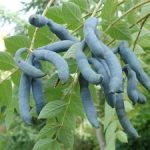
Dead man’s Fingers
fargesii, Dead Man’s Fingers. It’s named after Joseph Decaisne and Pere Farges. No description there… seems like a lost opportunity to me… Sometimes the species name is misleading as the Longleaf Pine, Pinus palustris, which means a pine that likes to grow in swamps. Unfortunately Pinus palustris only grows on the top of dry sandy hills. That the descriptive name is very wrong is not enough to get it changed. The reason to change a name has to be botanical even if flimsy botanical.
-ifera and -oides however usually are helpful. -ifera means “producing” or “bearing.” Papyrifera means paper bearing, as in Betula papyrifera, the Paper Birch, left. Bulbifera means bulb bearing, such as the Dioscorea bulbifera, the Air Potato. Cerifera means wax bearing like the Southern Wax Myrtle, Myrica cerifera. Myrica cerifera produces a green wax that was traditionally used to make Bayberry Candles.
-oides means “resembling” or ‘looks like.”Tillandsia usneoides (Spanish Moss) means looks like the lichen Usnea. Ranunculoides means looks like ranunculus. Centruroides means … like sharp (and is also the genus of scorpions in reference to their stingers.) While the -folia can mean leaves it is also used to mean looks like. Aquifolium means holly-like leaves. Tiliifolia — yes four “i’s” — means basswood-like leaves. Sonchifolia means leaves like a sow thistle. So if you have an -ifera in front of you it should be producing something. If you have an -oides it should look like something else you probably already know. -Folia is usually also descriptive.
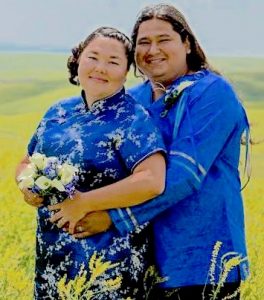
Keynote Speakers at the Florida Herbal Conference Linda and Luke Black Elk.
It’s time to be thinking about two conferences in February, Earthskills in Hawthorn, and the Florida Herbal Conference near Lake Wales. I lead plant walks at both events. Earthskills is Feb 7-11 and the Florida Herbal Conference is Feb 23-25. Both are now accepting registration. You can register at Earthskills here. Because you read this newsletter you can get a discount for the Florida Herbal Conference. If you register for that conference between now and January 31 using the code FHC2018_GREENDEANE you can get a 30% discount. Keynote speakers this year at the Florida Herbal Conference are Linda and Luke Black Elk from the Standing Rock Reservation. Linda (of the Catawba Nation) is an ethnobotanist specializing in teaching about culturally important plants and their uses as food and medicine. She is a lecturer at Sitting Bull College in Fort Yates, North Dakota. Luke Black Elk (Thít?u?wa? Lakota) is a storyteller, grassroots activist, and traditional spiritualist. He has conducted research in water restoration, sustainable building design, and food sovereignty, and hopes to use these techniques to encourage a more traditional way of life among his people. Luke has lived on the Cheyenne River Sioux Reservation his entire life, becoming deeply involved in cultural and community activities. For more information about the Florida Herbal Conference go here.
This is issue 283.
If you would like to donate to Eat The Weeds please click here.


Hey Green Deane, we have had chickweed sprouting up here in the Tidewater area of Virginia for a few weeks now. There is a big patch growing in a neglected planter right next to my BBQ. It grows all winter long. I can snack on that while I cook up something. I am still learning to ID things, — chickweed is an easier one for me and tastes great.
I have also snacked on sorrel that grows year around. Not as much flavor as the chickweed, but easy enough to identify.
Also looking at what I think is “purple deadnettle” that is sprouting up all over. Still researching that one.